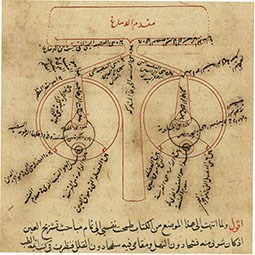Science in Islam
Islamic civilization was the primary inheritor of the classical tradition of mathematics, medicine, and the exact sciences. The population of the Arabian Peninsula was exposed to Hellenistic thought even before the Prophet Muhammad’s revelation, and increased during the period of the Umayyad caliphate (661-750). Under the Abbasids, however, since the second half of the eighth century, the engagement with and incorporation of this classical heritage increased exponentially. With direct caliphal patronage, the bulk of then-extant Greek works in the sciences were translated into Arabic. In many cases, translators, often themselves Christian, sought out copies of important works in monasteries and churches; in their work, the translators invented a versatile Arabic technical vocabulary that served generations of Muslim, Christian, and Jewish thinkers.
The incorporation of Greek thought was not limited to translation. Muslim scholars and scientists also wrote commentaries, syntheses, and refutations of classical works. This became the basis for an effervescent intellectual universe that continued to expand even after the seventeenth century encounter with European colonialism.
Alongside the Greek tradition, Indian, Babylonian, and Iranian theories, which were themselves already in conversation with each other and with Greek science before Islam, likewise contributed to the development of mathematics, astronomy, and other disciplines. The most famous example of this phenomenon is probably the development of algebra, a new, hybrid branch of mathematics born of the combination of Euclidean geometry with Babylonian problem-solving methods.
In terms of medicine, Galen (129-200 CE) was the unquestioned authority, the physician par excellence; while Galen’s own writings were sometimes contradictory, Islamic thinkers systematized and developed his thought. The Galenic theory of the four humors—yellow bile, black bile, phlegm, and blood—served as the theoretical basis for these later works. The most famous formulation of the Galenic system was the Canon of Medicine, written by the philosopher and physician Avicenna (Ibn Sīnā, 980-1034). Itself widely translated and studied, the Canon became the principal medical textbook in Europe as well as the Middle East up until modernity.
Few figures exemplify the interwovenness of these various currents better than Naṣīr al-Dīn al-Ṭūsī (1201-1274). An accomplished physician, astronomer, mathematician, philosopher, religious scholar, and poet, Tusi was an eyewitness to the epochal thirteenth-century Mongol invasion, eventually becoming a senior advisor to the Mongol emperor Hülegü. His astronomical treatises, in particular, became standard works, translated into numerous languages and likely influencing the European Renaissance.
In the Library collection you can read numerous digitized manuscripts of the works of Tusi, Avicenna, and other leading Muslim thinkers, as well as printed editions and translations of their works, and a thorough collection of scholarly research on the topic.

 Sign in with Google
Sign in with Google
 Sign in with Facebook
Sign in with Facebook


